Sensitivity Studies for a Hybrid Numerical–Statistical Short-Term Wind and Gust Forecast at Three Locations in the Basque Country (Spain)
Abstract
:1. Introduction
2. Material and Methods
2.1. Data
2.2. Method
- Observations of u and v, and the wind gust at each sensor height when t = 0;
- ERA-Interim forecasts (u, v, wind gust) for the nearest grid points from the selected locations (Figure 1). This NWF is based on a four-dimensional variational assimilation analysis, with a time window of 12 h, and produces forecasts with time steps that range from 3 to 24 h in the future, as explained in Section 2.1;
- Time-lagged wind observation at t − 0, t − 6, t − 12, and t − 18 h. Time-lagged observations and ERA-Interim analyses (see domain in Figure 3) were used. In order to reduce the dimensionality of the time-lagged ERA-Interim variables (Msl, u10, v10, and T2), extended empirical orthogonal functions (extEOFs) of the original variables were calculated [56,57]. In this way, both spatial and temporal patterns can be captured in the space corresponding to the principal components, and the leading extEOFs hold the highest fractions of the total variance. The resulting extended principal components have not been rotated, since they were just used for compressing the information and they are, therefore, orthogonal. Extended EOFs have been applied, dealing with different geophysical variables, such as waves [52,58], ENSO events [59], and surface moisture flux and precipitation [55]. In the case of this study, important associations (correlations) were detected between variables, in addition to non-negligible autocorrelations and spatial correlations throughout the selected spatial and time domain. Due to the different physical quantities (K, m/s and so on) of the variables involved, at an initial stage they were standardized (mean = 0, variance = 1), and the final number of leading extEOFs used for this study was 26, selected under the condition of jointly retaining at least 90% of the overall variance, following the final criteria developed by authors for similar geophysical studies after careful evaluation of different alternatives [52,55].
- A number of bootstrap samples from original data are drawn and used to feed the different regression trees;
- At each tree, each node is split using the best among a subset of m predictors randomly chosen at that node.
3. Results
3.1. Model Performance for u and v
3.1.1. Statistical Models
3.1.2. Model Evaluation
3.1.3. Sensitivity to the Domain Size
3.1.4. Identification of Relevant Inputs
3.2. Model Performance for Wind Gusts
3.2.1. Model Evaluation
- All the information up to t = 0, last 3 h of observed wind gusts, and the same set of extEOFs corresponding to the initial domain and variables;
- Instead of using the u and v values observed at time t = 0, the selected input was the maximum wind gust since previous post-processing;
- The ERA-Interim forecasts were those corresponding to the upcoming maximum wind gusts. These forecasts involved 3 h time steps from t + 3 to t + 24 h.
3.2.2. Identification of Important Inputs
4. Discussion
5. Conclusions
Author Contributions
Funding
Acknowledgments
Conflicts of Interest
References
- Freebairn, J.W.; Zillman, J.W. Economic benefits of meteorological services. Meteorol. Appl. 2002, 9, 33–44. [Google Scholar] [CrossRef] [Green Version]
- Spanish Deparment of Economy Industry and Competitiveness. The Spanish Extraordinary Risk Coverage System; Spanish Deparment of Economy Industry and Competitiveness: Madrid, Spian, 2016; pp. 1987–2015. [Google Scholar]
- Liberato, M.L.R.; Pinto, J.G.; Trigo, I.F.; Trigo, R.M. Klaus-An exceptional winter storm over northern Iberia and southern France. Weather 2011, 66, 330–334. [Google Scholar] [CrossRef] [Green Version]
- Solari, G.; Repetto, M.P.; Burlando, M.; de Gaetano, P.; Pizzo, M.; Tizzi, M.; Parodi, M. The wind forecast for safety management of port areas. J. Wind Eng. Ind. Aerodyn. 2012, 104, 266–277. [Google Scholar] [CrossRef]
- Ibarra-Berastegi, G.; Elias, A.; Barona, A.; Saenz, J.; Ezcurra, A.; Diaz de Argandoña, J. From diagnosis to prognosis for forecasting air pollution using neural networks: Air pollution monitoring in Bilbao. Environ. Model. Softw. 2008, 23, 622–637. [Google Scholar] [CrossRef]
- Pinson, P. Wind Energy: Forecasting Challenges for Its Operational Management. Stat. Sci. 2013, 28, 564–585. [Google Scholar] [CrossRef] [Green Version]
- Soman, S.S.; Zareipour, H.; Malik, O.; Mandal, P. A review of wind power and wind speed forecasting methods with different time horizons. In Proceedings of the North American Power Symposium 2010, Arlington, TX, USA, 26–28 September 2010. [Google Scholar] [CrossRef]
- Cassola, F.; Burlando, M. Wind speed and wind energy forecast through Kalman filtering of Numerical Weather Prediction model output. Appl. Energy 2012, 99, 154–166. [Google Scholar] [CrossRef]
- Barbounis, T.G.; Theocharis, J.B.Ã. Locally recurrent neural networks for long-term wind speed and power prediction. Neurocomputing 2006, 69, 466–496. [Google Scholar] [CrossRef]
- Santamaría-Bonfil, G.; Reyes-Ballesteros, A.; Gershenson, C. Wind speed forecasting for wind farms: A method based on support vector regression. Renew. Energy 2016, 85, 790–809. [Google Scholar] [CrossRef]
- Feng, C.; Cui, M.; Hodge, B.M.; Zhang, J. A data-driven multi-model methodology with deep feature selection for short-term wind forecasting. Appl. Energy 2017, 190, 1245–1257. [Google Scholar] [CrossRef] [Green Version]
- Okumus, I.; Dinler, A. Current status of wind energy forecasting and a hybrid method for hourly predictions. Energy Convers. Manag. 2016, 123, 362–371. [Google Scholar] [CrossRef]
- Wang, H.; Lei, Z.; Zhang, X.; Zhou, B.; Peng, J. A review of deep learning for renewable energy forecasting. Energy Convers. Manag. 2019, 198, 111799. [Google Scholar] [CrossRef]
- Cheney, N.P.; Gould, J.S.; Catchpole, W.R. The Influence Of Fuel, Weather And Fire Shape Variables On Fire-Spread In Grasslands. Int. J. Wildl. Fire 1993, 3, 31–44. [Google Scholar] [CrossRef]
- Del Prete, R.; Pezzoli, A.; Pezzoli, G. Current methods for meteorological and marine forecasting for the assistance of navigation and shipping operations. J. Navig. 1999, 52, 104–118. [Google Scholar] [CrossRef]
- Tagliaferri, F.; Viola, I.M.; Flay, R.G.J. Wind direction forecasting with artificial neural networks and support vector machines. Ocean Eng. 2015, 97, 65–73. [Google Scholar] [CrossRef] [Green Version]
- Traveria, M.; Escribano, A.; Palomo, P. Statistical wind forecast for Reus airport. Meteorol. Appl. 2010, 17, 485–495. [Google Scholar] [CrossRef]
- Rozas-Larraondo, P.; Inza, I.; Lozano, J.A. A Method for Wind Speed Forecasting in Airports Based on Nonparametric Regression. Weather Forecast. 2014, 29, 1332–1342. [Google Scholar] [CrossRef]
- Lewis, J.M.; Lakshmivarahan, S.; Dhall, S. Dynamic Data Assimilation; Cambridge University Press: Cambridge, UK, 2009. [Google Scholar]
- Cushman-Roisin, B.; Beckers, J.-M. Introduction to Geophysical Fluid Dynamics - Physical and Numerical Aspects. Int. Geophys. 2011, 101, 701–724. [Google Scholar]
- Dee, D.P.; Uppala, S.M.; Simmons, A.J.; Berrisford, P.; Poli, P.; Kobayashi, S.; Andrae, U.; Balmaseda, M.A.; Balsamo, G.; Bauer, P.; et al. The ERA-Interim reanalysis: Configuration and performance of the data assimilation system. Q. J. R. Meteorol. Soc. 2011, 137, 553–597. [Google Scholar] [CrossRef]
- Kalnay, E.; Kanamitsu, M.; Kistler, R.; Collins, W.; Deaven, D.; Gandin, L.; Iredell, M.; Saha, S.; White, G.; Woollen, J.; et al. The NCEP/NCAR 40-year reanalysis project. Bull. Am. Meteorol. Soc. 1996, 77, 437–471. [Google Scholar] [CrossRef] [Green Version]
- Skamarock, W.C.; Klemp, J.B.; Dudhi, J.; Gill, D.O.; Barker, D.M.; Duda, M.G.; Huang, X.-Y.; Wang, W.; Powers, J.G. A Description of the Advanced Research WRF Version 3. NCAR Tech. Note NCAR/TN-475+STR; University Corporation for Atmospheric Research: Boulder, CO, USA, 2008; p. 113. [Google Scholar]
- Pielke, R.A.; Cotton, W.R.; Walko, R.L.; Tremback, C.J.; Lyons, W.A.; Grasso, L.D.; Nicholls, M.E.; Moran, M.D.; Wesley, D.A.; Lee, T.J.; et al. A comprehensive meteorological modeling system-RAMS. Meteorol. Atmos. Phys. 1992, 49, 69–91. [Google Scholar] [CrossRef]
- Unden, P.; Rontu, L.; Jarvinen, H.; Lynch, P.; Calvo, J.; Cats, G.; Cuxart, J.; Eerola, K.; Fortelius, C.; Garcia-moya, J.A.; et al. HIRLAM-5 Scientific Documentation. 2002. Available online: http://citeseerx.ist.psu.edu/viewdoc/summary?doi=10.1.1.6.3794 (accessed on 28 November 2019).
- Valero, F.; Pascual, A.; Martín, M.L. An approach for the forecasting of wind strength tailored to routine observational daily wind gust data. Atmos. Res. 2014, 137, 58–65. [Google Scholar] [CrossRef]
- Pascual, A.; Valero, F.; Martín, M.L.; Morata, A.; Luna, M.Y. Probabilistic and deterministic results of the ANPAF analog model for Spanish wind field estimations. Atmos. Res. 2012, 108, 39–56. [Google Scholar] [CrossRef]
- Environmental Modeling Center. The GFS Atmospheric Model, Note 442; Environmental Modeling Center: College Park, MA, USA, 2003.
- Janjic, Z.; Gall, R.; Pyle, M.E. Scientific Doucmentation for NMM Solver. 2010. Available online: https://opensky.ucar.edu/islandora/object/technotes%3A490 (accessed on 28 November 2019).
- Benjamin, S.G.; Grell, G.A.; Brown, J.M.; Smirnova, T.G.; Bleck, R. Mesoscale Weather Prediction with the RUC Hybrid Isentropic–Terrain-Following Coordinate Model. Mon. Weather. Rev. 2004, 132, 473–494. [Google Scholar] [CrossRef]
- Nagarajan, B.; Delle Monache, L.; Hacker, J.P.; Rife, D.L.; Searight, K.; Knievel, J.C.; Nipen, T.N. An Evaluation of Analog-Based Postprocessing Methods across Several Variables and Forecast Models. Weather Forecast. 2015, 30, 1623–1643. [Google Scholar] [CrossRef]
- Buzzi, A.; Fantini, M.; Malguzzi, P.; Nerozzi, F. Validation of a limited area model in cases of mediterranean cyclogenesis: Surface fields and precipitation scores. Meteorol. Atmos. Phys. 1994, 53, 137–153. [Google Scholar] [CrossRef]
- Zhao, W.; Wei, Y.M.; Su, Z. One day ahead wind speed forecasting: A resampling-based approach. Appl. Energy 2016, 178, 886–901. [Google Scholar] [CrossRef]
- Manor, A.; Berkovic, S. Bayesian Inference aided analog downscaling for near-surface winds in complex terrain. Atmos. Res. 2015, 164–165, 27–36. [Google Scholar] [CrossRef]
- Patlakas, P.; Drakaki, E.; Galanis, G.; Drakaki, E. Wind gust estimation by combining a numerical weather prediction model and statistical post-processing. Energy Procedia 2017, 125, 190–198. [Google Scholar] [CrossRef]
- Spyrou, C.; Mitsakou, C.; Kallos, G.; Louka, P.; Vlastou, G. An improved limited area model for describing the dust cycle in the atmosphere. J. Geophys. Res. Atmos. 2010, 115, 1–19. [Google Scholar] [CrossRef]
- Zjavka, L. Wind speed forecast correction models using polynomial neural networks. Renew. Energy 2015, 83, 998–1006. [Google Scholar] [CrossRef]
- Bouttier, F. The Météo-France NWP System: Description, Recent Changes and Plans. 2010. Available online: http://www.umr-cnrm.fr/gmap/nwp/nwpreport.pdf (accessed on 28 November 2019).
- Fernández-Ferrero, A.; Sáenz, J.; Ibarra-Berastegi, G.; Fernández, J. Evaluation of statistical downscaling in short range precipitation forecasting. Atmos. Res. 2009, 94, 448–461. [Google Scholar] [CrossRef]
- Raible, C.C.; Bischof, G.; Fraedrich, K.; Kirk, E. Statistical Single-Station Short-Term Forecasting of Temperature and Probability of Precipitation: Area Interpolation and NWP Combination. Weather Forecast. 1999, 14, 203–214. [Google Scholar] [CrossRef]
- Torres, J.L.; García, A.; De Blas, M.; De Francisco, A. Forecast of hourly average wind speed with ARMA models in Navarre (Spain). Sol. Energy 2005, 79, 65–77. [Google Scholar] [CrossRef]
- Müller, M.D. Effects of model resolution and statistical postprocessing on shelter temperature and wind forecasts. J. Appl. Meteorol. Climatol. 2011, 50, 1627–1636. [Google Scholar] [CrossRef] [Green Version]
- Kulkarni, M.A.; Patil, S.; Rama, G.V.; Sen, P.N. Wind speed prediction using statistical regression and neutral network. J. Earth Syst. Sci. 2008, 117, 457–463. [Google Scholar] [CrossRef] [Green Version]
- Li, G.; Shi, J. On comparing three artificial neural networks for wind speed forecasting. Appl. Energy 2010, 87, 2313–2320. [Google Scholar] [CrossRef]
- Ezzat, A.A.; Jun, M.; Ding, Y. Spatio-temporal short-term wind forecast: A calibrated regime-switching method By Ahmed Aziz Ezzat, Mikyoung Jun and Yu Ding Texas A&M University. Ann. Appl. Stat. 2019, 13, 1484–1510. [Google Scholar]
- Ding, Y. Data Science for Wind Energy; Chapman & Hall/CRC: Boca Raton, FL, USA, 2019; ISBN 9781138590526. [Google Scholar]
- Liu, H.; Tian, H.Q.; Li, Y.F. Comparison of two new ARIMA-ANN and ARIMA-Kalman hybrid methods for wind speed prediction. Appl. Energy 2012, 98, 415–424. [Google Scholar] [CrossRef]
- Ahmed, A.; Khalid, M.; Ahmed, A.; Khalid, M. Multi-step Ahead Wind Forecasting Using Nonlinear Autoregressive Neural Networks. Energy Procedia 2017, 134, 192–204. [Google Scholar] [CrossRef]
- Zorita, E.; von Storch, H. The analog method as a simple statistical downscaling technique:comparison with more complicated methods. J. Clim. 1999, 12, 2474–2489. [Google Scholar] [CrossRef]
- Hu, Q.; Su, P.; Yu, D.; Liu, J. Pattern-Based Wind Speed Prediction Based on Generalized Principal Component Analysis. Sustain. Energy IEEE Trans. 2014, 5, 866–874. [Google Scholar] [CrossRef]
- do Camelo, H.N.; Lucio, P.S.; Junior, J.B.V.L.; von Glehn dos Santos, D.; de Carvalho, P.C.M. Innovative hybrid modeling ofwind speed prediction involving time-series models and artificial neural networks. Atmosphere 2018, 9, 77. [Google Scholar]
- Ibarra-Berastegi, G.; Saénz, J.; Esnaola, G.; Ezcurra, A.; Ulazia, A. Short-term forecasting of the wave energy flux: Analogues, random forests, and physics-based models. Ocean Eng. 2015, 104, 530–539. [Google Scholar] [CrossRef]
- Puertos del Estado. Available online: http://www.puertos.es/es-es (accessed on 3 March 2019).
- ECMWF | Public Datasets. Available online: https://apps.ecmwf.int/datasets/ (accessed on 3 March 2019).
- Ibarra-Berastegi, G.; Saénz, J.; Ezcurra, A.; Elías, A.; Diaz Argandoña, J.; Errasti, I. Downscaling of surface moisture flux and precipitation in the Ebro Valley (Spain) using analogues and analogues followed by random forests and multiple linear regression. Hydrol. Earth Syst. Sci. 2011, 15, 1895–1907. [Google Scholar] [CrossRef]
- Hannachi, A.; Jolliffe, I.T.; Stephenson, D.B. Review Empirical orthogonal functions and related techniques in atmospheric science: A review. Int. J. Climatol. 2007, 27, 1119–1152. [Google Scholar] [CrossRef]
- Weare, B.C.; Nasstrom, J.S. Examples of Extended Empirical Orthogonal Function Analyses. Mon. Weather. Rev. 1982, 110, 481–485. [Google Scholar] [CrossRef]
- Fukutomi, Y.; Yasunari, T. Structure and characteristics of submonthly-scale waves along the Indian Ocean ITCZ. Clim. Dyn. 2013, 40, 1819–1839. [Google Scholar] [CrossRef] [Green Version]
- Tangang, F.T.; Tang, B.; Monahan, A.H.; Hsieh, W.W. Forecasting ENSO events: A neural network-extended EOF approach. J. Clim. 1998, 11, 29–41. [Google Scholar] [CrossRef]
- Matulla, C.; Zang, X.; Wang, X.L.; Wang, J.; Zorita, E.; Wagner, S.; von Storch, H. Influence of similarity measures on the performance of the analog method for downscaling daily precipitation. Clim. Dyn. 2008, 30, 133–144. [Google Scholar] [CrossRef]
- Breiman, L. Random Forests. Mach. Learn. 2001, 45, 5–32. [Google Scholar] [CrossRef] [Green Version]
- Quinlan, J.R. Induction of decision trees. Mach. Learn. 1986, 1, 81–106. [Google Scholar] [CrossRef] [Green Version]
- Grömping, U. Variable importance assessment in regression: Linear regression versus random forest. Am. Stat. 2009, 63, 308–319. [Google Scholar] [CrossRef]
- Liaw, A.; Wiener, M. Classification and regression by randomForest. R News 2:18-22. Forest 2001, 23, 18–22. [Google Scholar]
- Siroky, D.S. Navigating random forests and related advances in algorithmic modeling. Stat. Surv. 2009, 3, 147–163. [Google Scholar] [CrossRef] [Green Version]
- Akaike, H. Factor analysis and AIC. Psychometrik 1987, 52, 317–332. [Google Scholar] [CrossRef]
- Weisberg, S. Applied Linear Regression; Wiley: Hoboken, NJ, USA, 2005. [Google Scholar]
- Eccel, E.; Ghielmi, L.; Granitto, P.; Barbiero, R.; Grazzini, F.; Cesari, D. Prediction of minimum temperatures in an alpine region by linear and non-linear post-processing of meteorological models. Nonlinear Process. Geophys. 2007, 14, 211–222. [Google Scholar] [CrossRef] [Green Version]
- Lahouar, A.; Ben Hadj Slama, J. Hour-ahead wind power forecast based on random forests. Renew. Energy J. 2017, 109, 529–541. [Google Scholar] [CrossRef]
- Serras, P.; Ibarra-Berastegi, G.; Sáenz, J.; Ulazia, A. Combining random forests and physics-based models to forecast the electricity generated by ocean waves: A case study of the Mutriku wave farm. Ocean Eng. 2019, 189, 106314. [Google Scholar] [CrossRef]
- Hastie, T.; Tibsharani, R.; Friedman, J. The Elements of Statistical Learning; Springer: Berlin, Germany, 2001; Volume 27, ISBN 9780387848570. [Google Scholar]
- Stanski, H.R.; Wilson, L.J.; Burrows, W.R. Survey of Common Verfication Methods in Meteorology. Atmos. Res. 1989, 9–42. [Google Scholar]
- Efron, B. Bootstrap Methods: Another Look at the Jackknife. Ann. Stat. 1979, 7, 1–26. [Google Scholar] [CrossRef]
- Haiden, T.; Janousek, M.; Bidlot, J.; Ferranti, L.; Prates, F.; Vitart, F.; Richardson, D.; Bauer, P. Evaluation of ECMWF Forecasts, Including the 2016 Resolution Upgrade; ECMWF: Shinfield, UK, 2016. [Google Scholar] [CrossRef]
- Kariniotakis, G.; Halliday, J.; Brownsword, R.; Marti, I.; Palomares, A.M.; Cruz, I.; Madsen, H.; Nielsen, T.S.; Nielsen, H.A.; Focken, U.; et al. Next Generation Short-Term Forecasting of Wind Power―Overview of the ANEMOS Project. Eur. Wind Energy Conf. EWEC. 2006. Available online: http://www.ewec2006proceedings.info/all (accessed on 28 November 2019).
- Ibarra-berastegi, G.; Sáenz, J.; Ulazia, A.; Serras, P.; Esnaola, G. Electricity production, capacity factor, and plant efficiency index at the Mutriku wave farm (2014–2016). Ocean Eng. 2018, 147, 20–29. [Google Scholar] [CrossRef] [Green Version]
- R Core Team. R: A Language and Environment for Statistical Computing; R Found Stat. Comput.: Vienna, Austria, 2018. Available online: http://softlibre.unizar.es/manuales/aplicaciones/r/fullrefman.pdf (accessed on 28 November 2019).
- Wessel, P.; Smith, W.H.F.; Scharroo, R.; Luis, J.; Wobbe, F. The Generic Mapping Tools (GMT) version 5 GMT 5: A major new release of the Generic Mapping Tools. Generic Mapp. Tools (GMT) 2011, 7, 2–5. [Google Scholar]
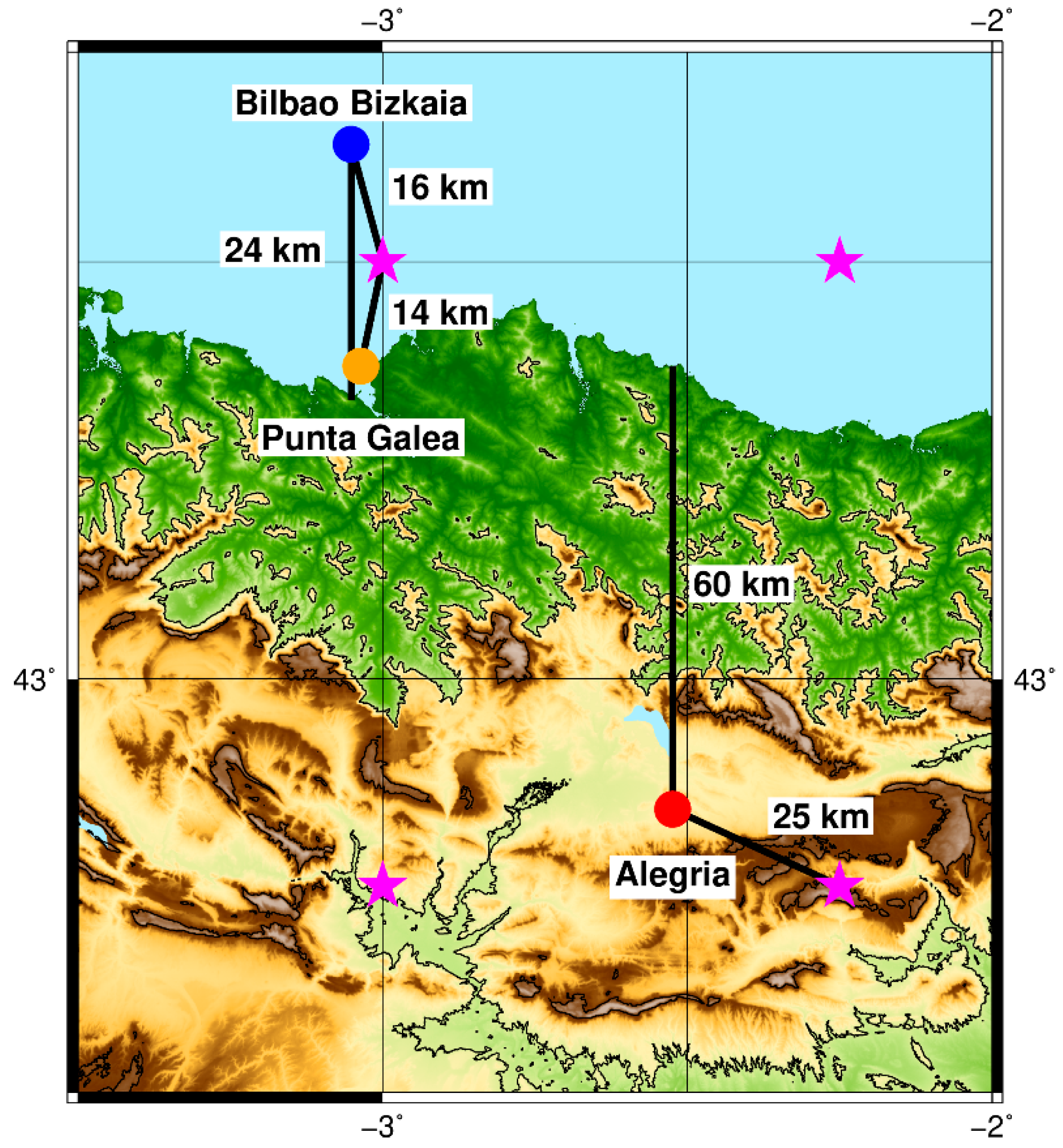

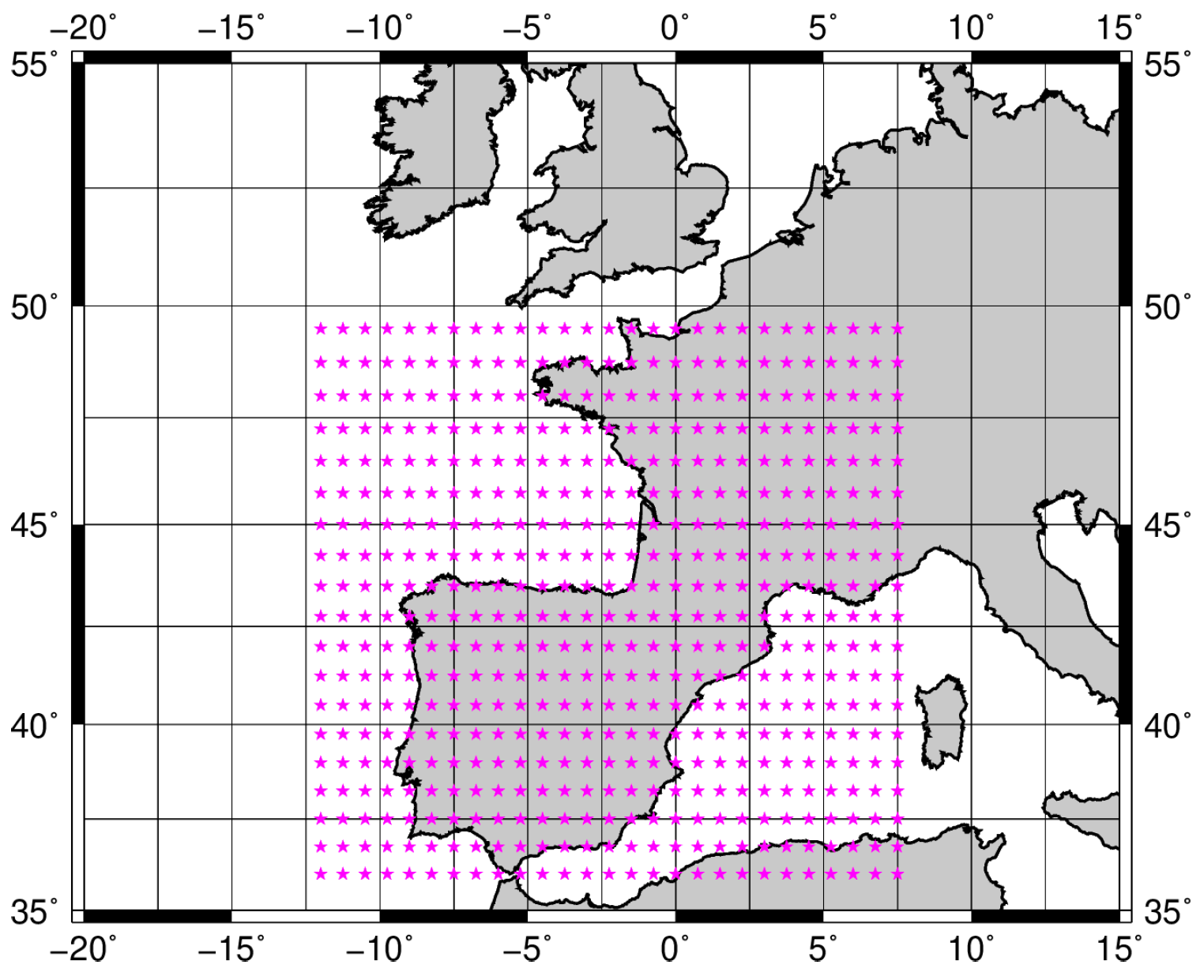
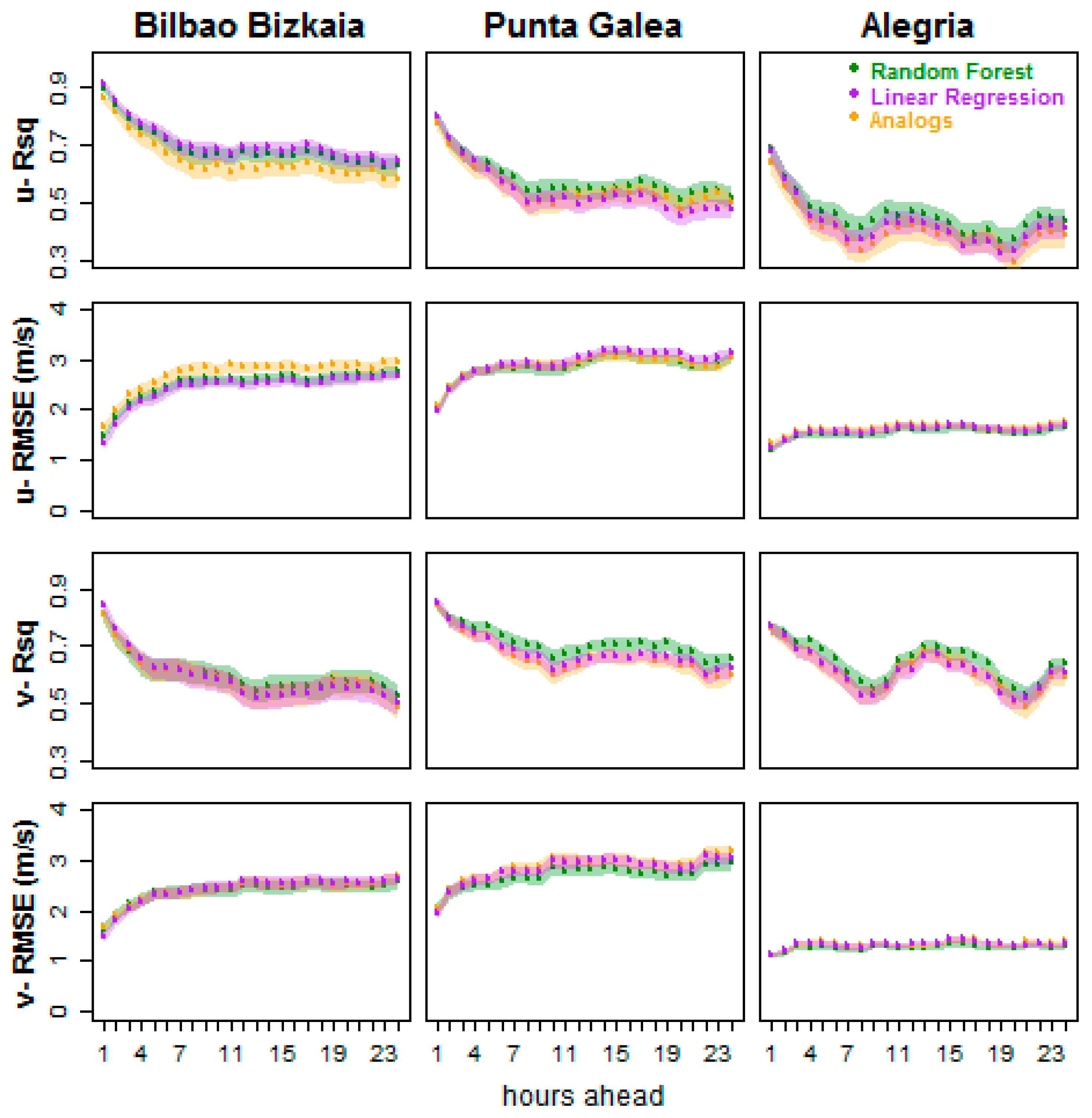
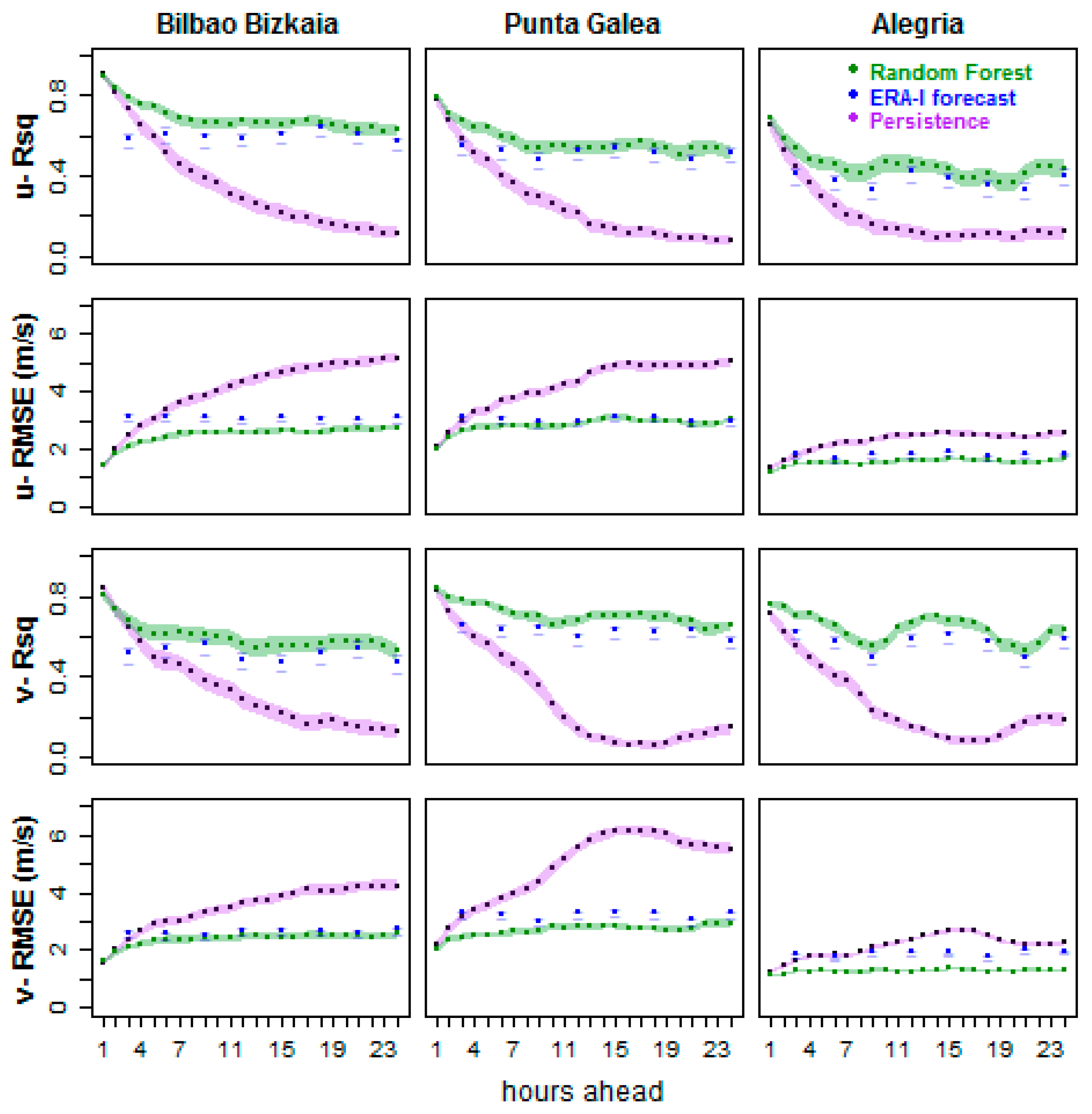
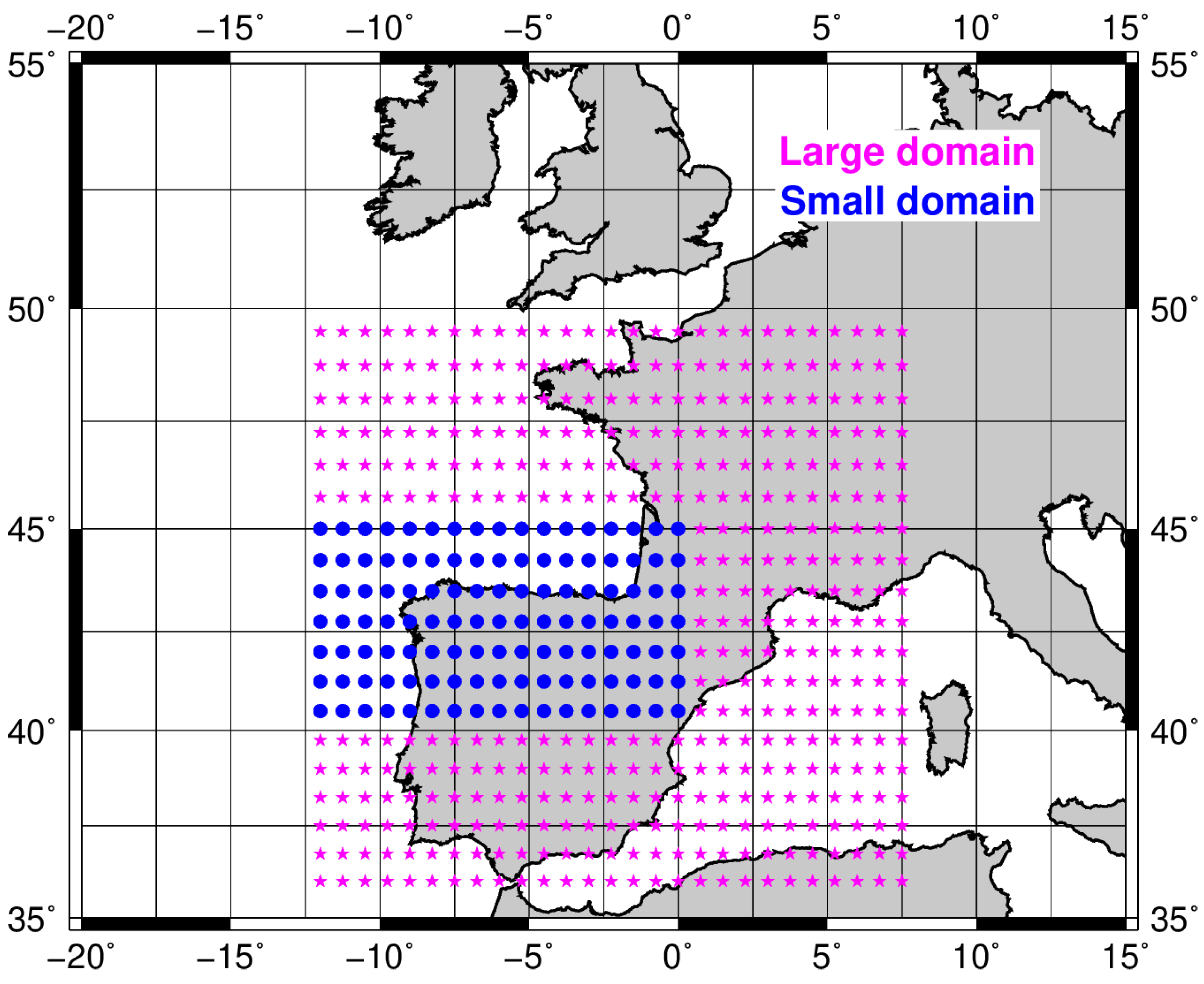
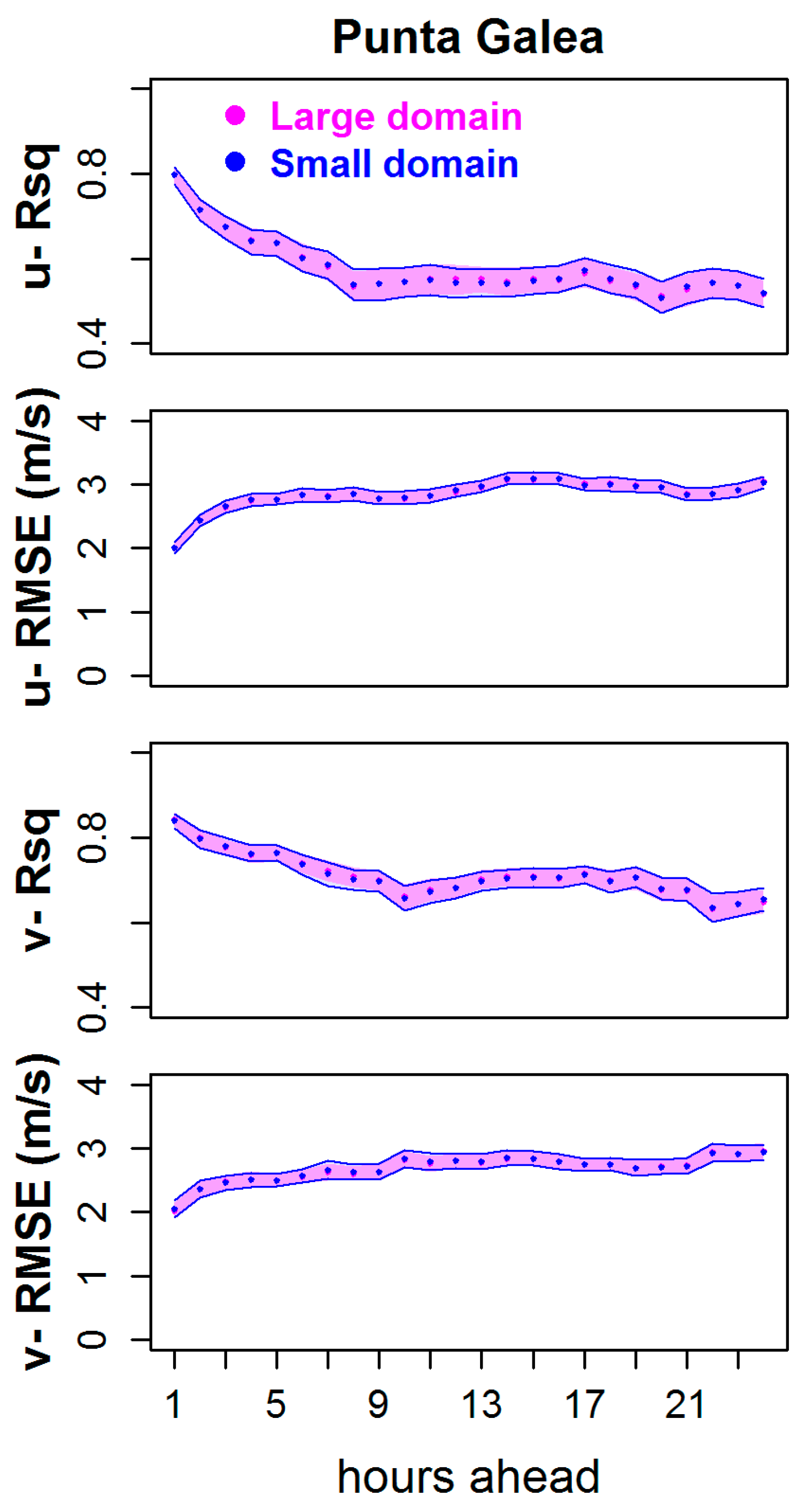
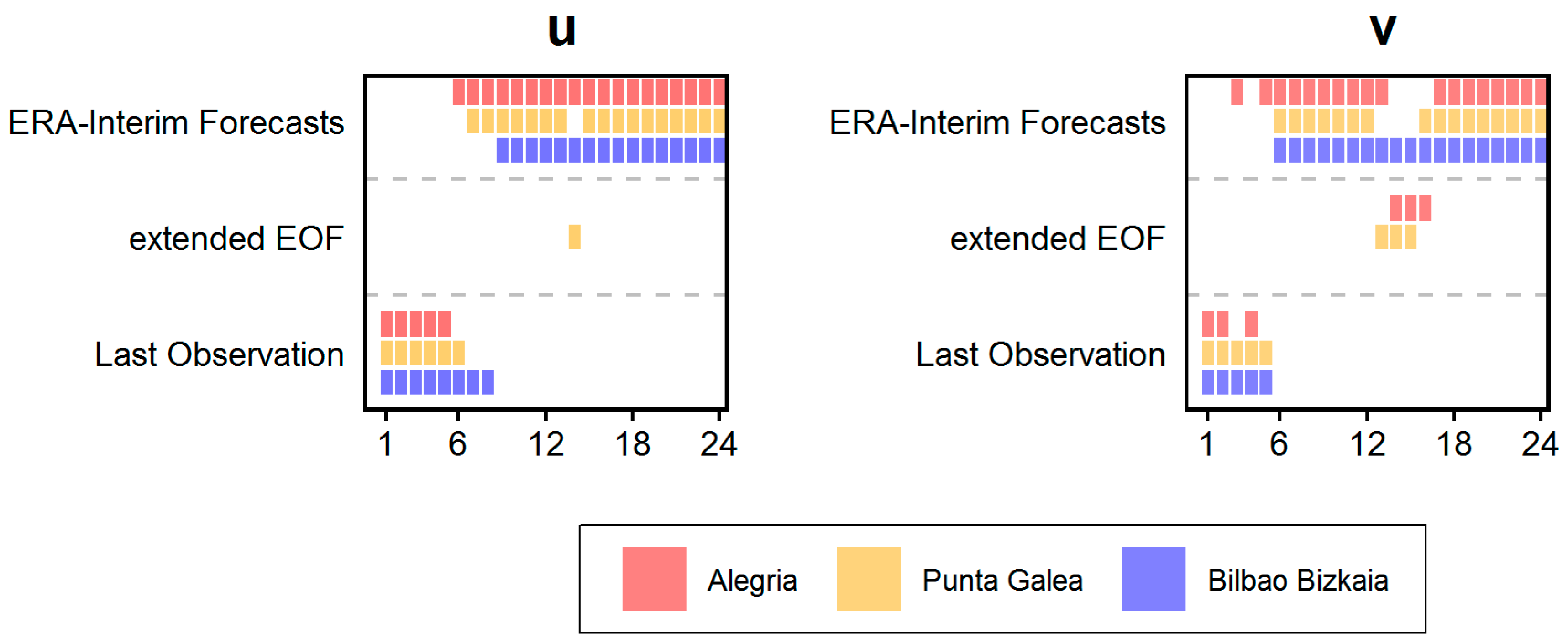
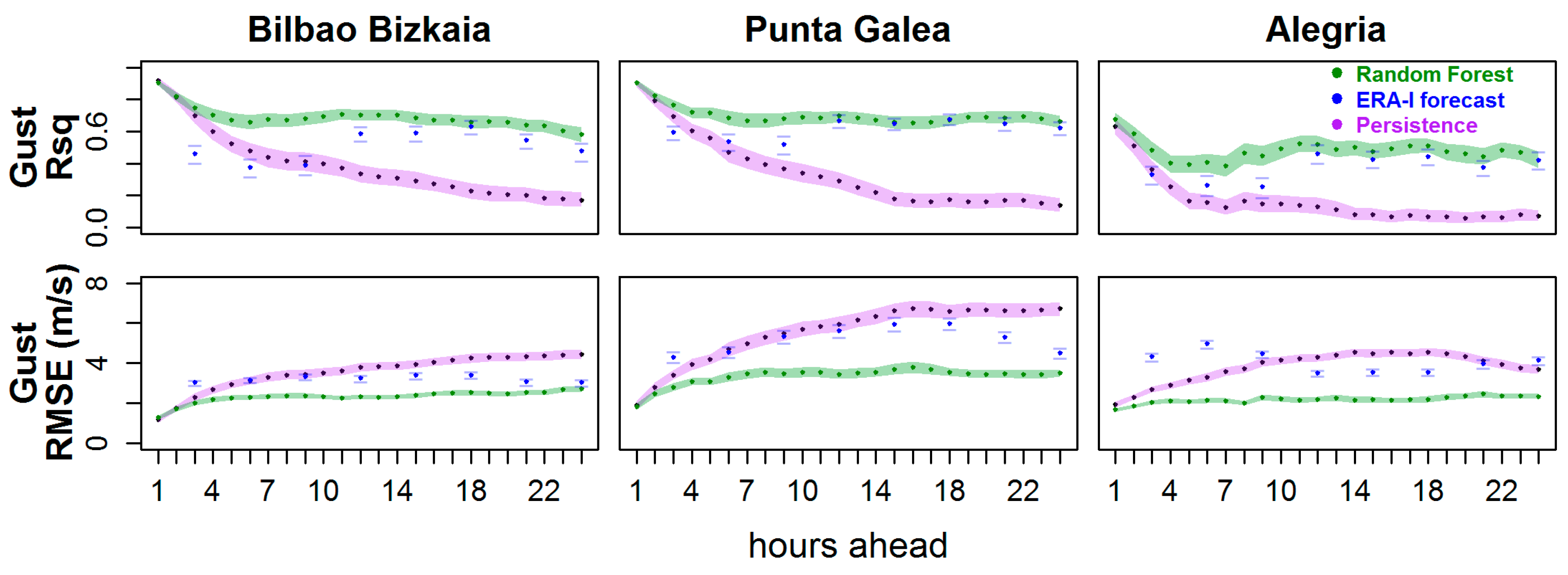

| Data | Train | Test | |
|---|---|---|---|
| Bilbao Bizkaia Buoy | 3792 | 1896 | 1896 |
| Punta Galea Station | 4461 | 2231 | 2230 |
| Alegria Station | 4084 | 2042 | 2042 |
| Name | Variables | Source | Time |
|---|---|---|---|
| Last obs | u, v, wind gust | Observations | t h |
| ERA-I Forecast | u10, v10, wind gust | ERA-I forecast | t + 3, t + 6, … t + 24 h |
| ExtEOF | Msl, u10, v10, T2 (domain) u, v, wind gust | ERA-I analisis Observations | t, t − 6, t − 12, t − 18 h |
| 1 h | 6 h | 12 h | 18 h | 24 h | |||
|---|---|---|---|---|---|---|---|
| u | BB | RF | 0.89–0.91 | 0.69–0.74 | 0.65–0.7 | 0.64–0.7 | 0.6–0.65 |
| AN | 0.85–0.88 | 0.64–0.7 | 0.59–0.65 | 0.58–0.65 | 0.55–0.61 | ||
| LR | 0.9–0.92 | 0.7–0.75 | 0.67–0.72 | 0.65–0.71 | 0.62–0.67 | ||
| PG | RF | 0.78–0.82 | 0.57–0.63 | 0.51–0.58 | 0.52–0.59 | 0.49–0.55 | |
| AN | 0.75–0.79 | 0.53–0.59 | 0.48–0.55 | 0.49–0.56 | 0.47–0.54 | ||
| LR | 0.78–0.82 | 0.54–0.61 | 0.46–0.53 | 0.47–0.54 | 0.45–0.51 | ||
| Al | RF | 0.65–0.71 | 0.42–0.5 | 0.42–0.51 | 0.37–0.45 | 0.39–0.48 | |
| AN | 0.6–0.67 | 0.37–0.45 | 0.37–0.46 | 0.33–0.42 | 0.34–0.43 | ||
| LR | 0.64–0.71 | 0.38–0.46 | 0.39–0.47 | 0.33–0.4 | 0.37–0.46 | ||
| v | BB | RF | 0.78–0.83 | 0.57–0.65 | 0.52–0.6 | 0.51–0.6 | 0.48–0.57 |
| AN | 0.78–0.83 | 0.58–0.65 | 0.5–0.58 | 0.51–0.59 | 0.45–0.53 | ||
| LR | 0.82–0.86 | 0.59–0.66 | 0.49–0.57 | 0.51–0.59 | 0.46–0.54 | ||
| PG | RF | 0.82–0.86 | 0.71–0.76 | 0.66–0.71 | 0.67–0.72 | 0.63–0.68 | |
| AN | 0.82–0.86 | 0.66–0.71 | 0.61–0.66 | 0.62–0.67 | 0.57–0.63 | ||
| LR | 0.83–0.87 | 0.67–0.72 | 0.62–0.67 | 0.64–0.68 | 0.59–0.65 | ||
| Al | RF | 0.75–0.79 | 0.62–0.68 | 0.64–0.69 | 0.61–0.66 | 0.61–0.67 | |
| AN | 0.74–0.78 | 0.57–0.63 | 0.61–0.66 | 0.56–0.62 | 0.56–0.62 | ||
| LR | 0.75–0.79 | 0.58–0.64 | 0.59–0.64 | 0.56–0.62 | 0.58–0.63 |
| 1 h | 6 h | 12 h | 18 h | 24 h | |||
|---|---|---|---|---|---|---|---|
| u | BB | RF | 1.41–1.55 | 2.33–2.55 | 2.46–2.66 | 2.49–2.73 | 2.65–2.84 |
| AN | 1.58–1.75 | 2.53–2.78 | 2.72–2.94 | 2.73–2.96 | 2.83–3.04 | ||
| LR | 1.24–1.42 | 2.27–2.49 | 2.4–2.58 | 2.43–2.65 | 2.57–2.77 | ||
| PG | RF | 1.92–2.09 | 2.74–2.94 | 2.81–3 | 2.9–3.12 | 2.94–3.13 | |
| AN | 2–2.18 | 2.79–2.98 | 2.85–3.05 | 2.91–3.1 | 2.94–3.14 | ||
| LR | 1.89–2.08 | 2.81–3 | 2.94–3.13 | 3.04–3.23 | 3.03–3.22 | ||
| Al | RF | 1.15–1.27 | 1.43–1.58 | 1.54–1.69 | 1.5–1.65 | 1.59–1.74 | |
| AN | 1.26–1.39 | 1.5–1.66 | 1.63–1.76 | 1.53–1.69 | 1.67–1.82 | ||
| LR | 1.17–1.29 | 1.48–1.64 | 1.61–1.73 | 1.54–1.7 | 1.63–1.77 | ||
| v | BB | RF | 1.53–1.74 | 2.24–2.5 | 2.36–2.61 | 2.4–2.69 | 2.45–2.69 |
| AN | 1.56–1.73 | 2.23–2.47 | 2.43–2.67 | 2.43–2.7 | 2.55–2.79 | ||
| LR | 1.38–1.58 | 2.21–2.44 | 2.45–2.69 | 2.45–2.71 | 2.52–2.75 | ||
| PG | RF | 1.92–2.18 | 2.47–2.68 | 2.7–2.92 | 2.66–2.86 | 2.83–3.06 | |
| AN | 1.91–2.14 | 2.67–2.9 | 2.9–3.14 | 2.84–3.07 | 3.06–3.3 | ||
| LR | 1.84–2.07 | 2.65–2.85 | 2.86–3.07 | 2.8–3.01 | 2.95–3.17 | ||
| Al | RF | 1.07–1.16 | 1.2–1.3 | 1.21–1.3 | 1.21–1.31 | 1.23–1.34 | |
| AN | 1.08–1.17 | 1.27–1.39 | 1.27–1.37 | 1.28–1.39 | 1.31–1.43 | ||
| LR | 1.07–1.15 | 1.27–1.37 | 1.29–1.38 | 1.28–1.38 | 1.3–1.39 |
| 1 h | 6 h | 12 h | 18 h | 24 h | |||
|---|---|---|---|---|---|---|---|
| u | BB | RF | 0.89–0.91 | 0.69–0.74 | 0.65–0.7 | 0.64–0.7 | 0.6–0.65 |
| ERA-I F | 0.57–0.65 | 0.56–0.62 | 0.61–0.67 | 0.54–0.6 | |||
| Pers | 0.89–0.92 | 0.48–0.56 | 0.25–0.33 | 0.14–0.21 | 0.09–0.14 | ||
| PG | RF | 0.78–0.82 | 0.57–0.63 | 0.51–0.58 | 0.52–0.59 | 0.49–0.55 | |
| ERA-I F | 0.49–0.56 | 0.49–0.55 | 0.48–0.55 | 0.48–0.55 | |||
| Pers | 0.75–0.8 | 0.35–0.44 | 0.18–0.25 | 0.09–0.15 | 0.06–0.11 | ||
| Al | RF | 0.65–0.71 | 0.42–0.5 | 0.42–0.51 | 0.37–0.45 | 0.39–0.48 | |
| ERA-I F | 0.34–0.42 | 0.38–0.46 | 0.31–0.39 | 0.36–0.44 | |||
| Pers | 0.62–0.69 | 0.2–0.29 | 0.09–0.16 | 0.08–0.15 | 0.08–0.16 | ||
| v | BB | RF | 0.78–0.83 | 0.57–0.65 | 0.52–0.6 | 0.51–0.6 | 0.48–0.57 |
| ERA-I F | 0.5–0.58 | 0.45–0.53 | 0.48–0.56 | 0.43–0.51 | |||
| Pers | 0.81–0.86 | 0.43–0.52 | 0.25–0.33 | 0.14–0.22 | 0.09–0.16 | ||
| PG | RF | 0.82–0.86 | 0.71–0.76 | 0.66–0.71 | 0.67–0.72 | 0.63–0.68 | |
| ERA-I F | 0.61–0.66 | 0.57–0.63 | 0.6–0.65 | 0.55–0.61 | |||
| Pers | 0.8–0.85 | 0.46–0.54 | 0.11–0.17 | 0.04–0.08 | 0.12–0.18 | ||
| Al | RF | 0.75–0.79 | 0.62–0.68 | 0.64–0.69 | 0.61–0.66 | 0.61–0.67 | |
| ERA-I F | 0.55–0.61 | 0.56–0.62 | 0.55–0.6 | 0.56–0.61 | |||
| Pers | 0.68–0.74 | 0.36–0.44 | 0.12–0.18 | 0.06–0.11 | 0.15–0.22 |
| 1 h | 6 h | 12 h | 18 h | 24 h | |||
|---|---|---|---|---|---|---|---|
| u | BB | RF | 1.41–1.55 | 2.33–2.55 | 2.46–2.66 | 2.49–2.73 | 2.65–2.84 |
| ERA-I F | 3.05–3.27 | 2.97–3.17 | 2.97–3.18 | 3–3.21 | |||
| Pers | 1.31–1.51 | 3.21–3.56 | 4.15–4.5 | 4.7–5.07 | 5–5.37 | ||
| PG | RF | 1.92–2.09 | 2.74–2.94 | 2.81–3 | 2.9–3.12 | 2.94–3.13 | |
| ERA-I F | 3–3.18 | 2.87–3.05 | 3.02–3.2 | 2.92–3.11 | |||
| Pers | 1.95–2.2 | 3.51–3.84 | 4.21–4.52 | 4.74–5.09 | 4.9–5.25 | ||
| Al | RF | 1.15–1.27 | 1.43–1.58 | 1.54–1.69 | 1.5–1.65 | 1.59–1.74 | |
| ERA-I F | 1.63–1.78 | 1.77–1.89 | 1.69–1.85 | 1.82–1.95 | |||
| Pers | 1.28–1.44 | 2.06–2.29 | 2.42–2.64 | 2.37–2.58 | 2.42–2.65 | ||
| v | BB | RF | 1.53–1.74 | 2.24–2.5 | 2.36–2.61 | 2.4–2.69 | 2.45–2.69 |
| ERA-I F | 2.46–2.69 | 2.58–2.83 | 2.55–2.79 | 2.62–2.86 | |||
| Pers | 1.44–1.66 | 2.82–3.15 | 3.45–3.78 | 3.9–4.25 | 4.05–4.44 | ||
| PG | RF | 1.92–2.18 | 2.47–2.68 | 2.7–2.92 | 2.66–2.86 | 2.83–3.06 | |
| ERA-I F | 3.15–3.37 | 3.17–3.4 | 3.17–3.38 | 3.19–3.42 | |||
| Pers | 2–2.31 | 3.63–3.98 | 5.39–5.76 | 5.92–6.31 | 5.32–5.74 | ||
| Al | RF | 1.07–1.16 | 1.2–1.3 | 1.21–1.3 | 1.21–1.31 | 1.23–1.34 | |
| ERA-I F | 1.69–1.81 | 1.86–1.99 | 1.72–1.84 | 1.91–2.05 | |||
| Pers | 1.2–1.32 | 1.76–1.92 | 2.31–2.45 | 2.45–2.59 | 2.2–2.36 |
| 1 h | 6 h | 12 h | 18 h | 24 h | |||
|---|---|---|---|---|---|---|---|
| Gust | BB | RF | 0.9–0.93 | 0.67–0.72 | 0.64–0.69 | 0.61–0.67 | 0.58–0.64 |
| ERA-I F | 0.38–0.46 | 0.45–0.53 | 0.39–0.47 | 0.43–0.51 | |||
| Pers | 0.9–0.93 | 0.49–0.57 | 0.31–0.4 | 0.19–0.26 | 0.16–0.22 | ||
| PG | RF | 0.9–0.92 | 0.68–0.73 | 0.65–0.71 | 0.62–0.68 | 0.63–0.69 | |
| ERA-I F | 0.5–0.57 | 0.58–0.64 | 0.49–0.55 | 0.56–0.62 | |||
| Pers | 0.9–0.93 | 0.45–0.53 | 0.24–0.31 | 0.13–0.2 | 0.12–0.18 | ||
| Al | RF | 0.73–0.78 | 0.51–0.58 | 0.54–0.61 | 0.47–0.53 | 0.5–0.57 | |
| ERA-I F | 0.37–0.45 | 0.48–0.55 | 0.36–0.44 | 0.47–0.54 | |||
| Pers | 0.69–0.75 | 0.28–0.36 | 0.02–0.06 | 0–0.03 | 0.12–0.19 |
| 1 h | 6 h | 12 h | 18 h | 24 h | |||
|---|---|---|---|---|---|---|---|
| Gust | BB | RF | 1.14–1.28 | 2.19–2.35 | 2.34–2.53 | 2.4–2.57 | 2.55–2.74 |
| ERA-I F | 3.22–3.42 | 2.98–3.2 | 3.18–3.38 | 3.05–3.27 | |||
| Pers | 1.09–1.27 | 2.88–3.15 | 3.57–3.86 | 4.02–4.34 | 4.26–4.59 | ||
| PG | RF | 1.67–1.92 | 3.11–3.42 | 3.31–3.63 | 3.42–3.72 | 3.44–3.79 | |
| ERA-I F | 5.16–5.53 | 4.91–5.32 | 5.15–5.55 | 4.86–5.29 | |||
| Pers | 1.67–1.96 | 4.49–4.94 | 5.72–6.2 | 6.36–6.89 | 6.48–7.03 | ||
| Al | RF | 1.59–1.77 | 1.98–2.17 | 2.07–2.27 | 2.07–2.3 | 2.17–2.36 | |
| ERA-I F | 4.11–4.39 | 3.59–3.85 | 4.16–4.44 | 3.76–4.01 | |||
| Pers | 1.75–1.94 | 2.86–3.17 | 4.08–4.35 | 4.12–4.39 | 3.46–3.79 |
© 2019 by the authors. Licensee MDPI, Basel, Switzerland. This article is an open access article distributed under the terms and conditions of the Creative Commons Attribution (CC BY) license (http://creativecommons.org/licenses/by/4.0/).
Share and Cite
Carreno-Madinabeitia, S.; Ibarra-Berastegi, G.; Sáenz, J.; Zorita, E.; Ulazia, A. Sensitivity Studies for a Hybrid Numerical–Statistical Short-Term Wind and Gust Forecast at Three Locations in the Basque Country (Spain). Atmosphere 2020, 11, 45. https://doi.org/10.3390/atmos11010045
Carreno-Madinabeitia S, Ibarra-Berastegi G, Sáenz J, Zorita E, Ulazia A. Sensitivity Studies for a Hybrid Numerical–Statistical Short-Term Wind and Gust Forecast at Three Locations in the Basque Country (Spain). Atmosphere. 2020; 11(1):45. https://doi.org/10.3390/atmos11010045
Chicago/Turabian StyleCarreno-Madinabeitia, Sheila, Gabriel Ibarra-Berastegi, Jon Sáenz, Eduardo Zorita, and Alain Ulazia. 2020. "Sensitivity Studies for a Hybrid Numerical–Statistical Short-Term Wind and Gust Forecast at Three Locations in the Basque Country (Spain)" Atmosphere 11, no. 1: 45. https://doi.org/10.3390/atmos11010045
APA StyleCarreno-Madinabeitia, S., Ibarra-Berastegi, G., Sáenz, J., Zorita, E., & Ulazia, A. (2020). Sensitivity Studies for a Hybrid Numerical–Statistical Short-Term Wind and Gust Forecast at Three Locations in the Basque Country (Spain). Atmosphere, 11(1), 45. https://doi.org/10.3390/atmos11010045





